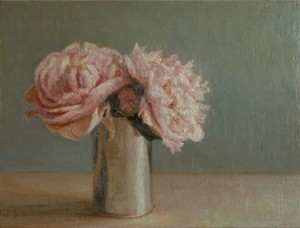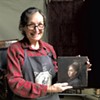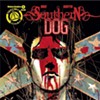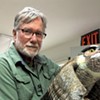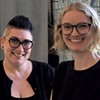Published May 14, 2014 at 9:00 a.m.
Tad Spurgeon says he never thought he'd leave Vermont "in a million years." But, despite his profound affinity for the area and the significant artistic inroads he's made since his arrival in 1982, Spurgeon packed up his Middlebury studio this spring to follow a longtime love back to his hometown.
"I didn't want to sacrifice Vermont for Philadelphia," the artist admits in a phone call from his new studio in Mount Airy, a northwestern suburb of the city within walking distance of his childhood home. "But in the end, blood is stronger than water, and I ended up back here."
Spurgeon, 59, leaves a significant artistic legacy in Vermont: as a painter of luminous still lifes, landscapes and color-block abstractions; as a teacher and mentor; and as author of a groundbreaking book — more on that in a moment. His first role in Vermont, however, was that of chef.
Just "trying to escape the heat of Philly," Spurgeon found work at prominent Burlington eateries. Within a year, he says, while working as pastry chef at the Ice House on Battery Street, he developed the chocolate recipes that would later help Ice House owner Jim Lampman launch Lake Champlain Chocolates.
In 1993, Spurgeon "left cooking for painting" — he'd been honing his technique in oil all the while — and became the first painting resident at the Shelburne Craft School. There Spurgeon devoted six years to teaching and painting. In the years that followed, he also mentored artists in private lessons, including Rebecca Kinkead, now a highly successful painter.
"He's just been an incredible resource for so many local artists," says the Ferrisburgh artist, who credits Spurgeon with helping her develop her signature wax medium and her comfortable relationship with color.
Turns out, it wasn't just culinary recipes that interested Spurgeon. In the early 2000s, he took a break from teaching to research his chosen medium, oil paint. Spurgeon began experimenting with formulas and techniques that had been disused for several centuries, attempting to capture the qualities he admired in the works of old masters. "I became fascinated with the idea that older painting was inherently different," he explains. The notion that those masters' oil paintings looked the way they did because of the paint upended his artistic worldview. Rembrandt's "secret," for example, involved using chalk along with oil and pigment.
"After that, I started working with chalk," Spurgeon remembers. "And I was, like, Oh! This is very different."
Spurgeon turned his discoveries and reflections into a book, titled Living Craft: A Painter's Process, which is now in its fourth edition (and available as a download from his website). He continues to make his own paints, and to explore.
"The foundation of his work and the real, true understanding of the materials and process has given him huge control over the nuance and the mood of the painting," notes Tari Swenson, co-owner of Stowe's West Branch Gallery. She acquired some Spurgeon paintings when the contemporary-art gallery built a wing for representational work earlier this year. "I think he's in more control of painting and the understanding of the process of painting than any other artist I know," Swenson adds.
Characteristically, Spurgeon shared his significant knowledge about oil mediums with his students — many of them accomplished artists themselves.
Bonnie Baird, a landscape painter in North Chittenden, says she began using chalk in her paintings after receiving a copy of Living Craft from a friend and taking a class with its author. Though she was initially dubious about the medium, she says, she found it "really creates this veil in the air of your skies. It makes the paint move a little better."
Baird says of Spurgeon, "He's presenting these tools to all of us that we were unaware of, through his own experiments and testing."
Another of Spurgeon's private painting students was Michael Strauss, a chemistry professor at the University of Vermont. Spurgeon asked Strauss how much salt he could put in the oil, in hopes that more salt would make the finished product dry more quickly. Strauss told him to use as much as he wanted.
"It was such a simple thing for him to say, but it changed everything," Spurgeon recalls. "I made a super-saturated solution, and suddenly I had an oil that dried overnight."
Strauss subsequently authored his own book, The Mind at Hand: What Drawing Reveals, an exploration of how the act of drawing affects consciousness; he devoted a chapter to an interview with Spurgeon. Reached by phone, the professor reveals that the chemistry Spurgeon performs is "actually really complicated. And there are very few people looking at the details of ... all these processes he's doing, because it's archaic," he says. "There is no practical use other than to a painter."
Spurgeon says practicality was beside the point of his experiments. "My final reward for doing the research was, it just changed my brain completely," he says. "At first I was just looking for a solution, but I became so fascinated by the journey that the destination became irrelevant."
Now back in Philly, Spurgeon says he's finding visual inspiration in his new Mount Airy neighborhood, which he describes as having an English feel: stucco and stone houses, streets lined with cherry trees that flower in April. He frequently hears from artists around the world who've read his book, and he plans to stay connected with his Vermont friends.
Sturgeon is also forging new creative paths. "There's a lot of work I sort of put on hold because it wasn't really going to fly in Vermont," he says. "Some of the more esoteric still-life work that wouldn't go over as well there. So I'm beginning to work on it here."
INFO
tadspurgeon.com
More By This Author
Speaking of...
-

Q&A: Catching Up With the Champlain Valley Quilt Guild
Apr 10, 2024 -

Video: The Champlain Valley Quilt Guild Prepares for Its Biennial Quilt Show
Apr 4, 2024 -

A Multilayered Career Leads a Seasoned Chef to Middlebury’s Swift House Inn
Mar 12, 2024 -

Middlebury: What to See, Do and Eat During the Eclipse
Mar 6, 2024 -

Middlebury's Champlain Valley Creamery Marks 20 Years With a Milestone Cheese
Feb 27, 2024 - More »
Comments
Comments are closed.
From 2014-2020, Seven Days allowed readers to comment on all stories posted on our website. While we've appreciated the suggestions and insights, right now Seven Days is prioritizing our core mission — producing high-quality, responsible local journalism — over moderating online debates between readers.
To criticize, correct or praise our reporting, please send us a letter to the editor or send us a tip. We’ll check it out and report the results.
Online comments may return when we have better tech tools for managing them. Thanks for reading.



































